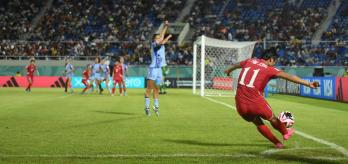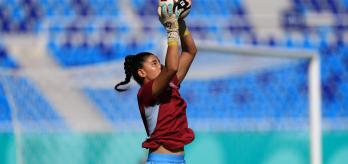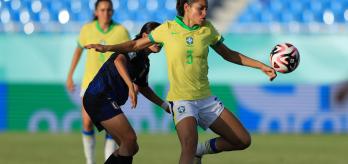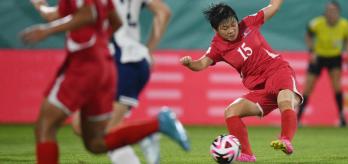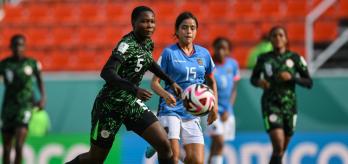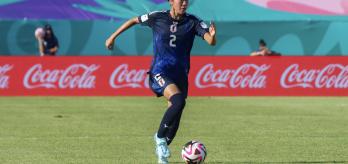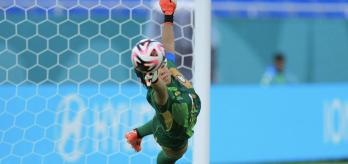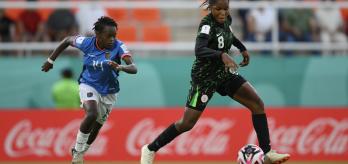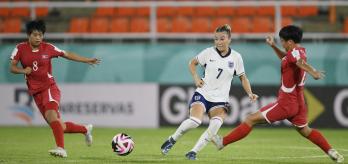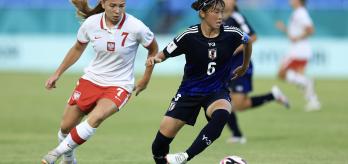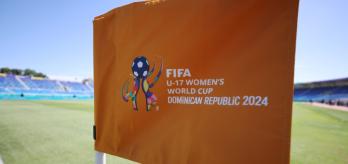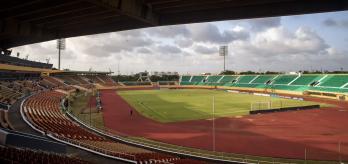During the FIFA U-17 Women’s World Cup Dominican Republic 2024™, our Football Performance Insights Team noted that a higher percentage of free kicks (that were defined as: a free kick with the attacking team’s centre-backs positioned in the final third in preparation for the delivery of the ball) resulted in an attempt at goal compared to corners in this tournament. However, a higher percentage of corners led to goals (3.5%) compared to 2.0% of free kicks.
As football is generally a low scoring game, just one goal can be the difference, so the ability to score from set plays is a valuable trait in a team. Of the 10 goals that were scored in corner phases in this tournament, five were game-state changing, meaning a team either went from losing to drawing or drawing to winning after scoring the goal, while all three goals from free kicks were game-state changing.
In total, goals in corner and free kick phases accounted for 13.8% of all goals in the competition (1 in 7 goals) with goals from corners accounting for 10% in isolation.
Interestingly, 11 of the 13 goals scored from these set plays were scored in the first phase (85%), highlighting the importance of the first contact, whether attacking or defending, during the first phase of the set play. It is also noteworthy that 88 of the 121 attempts at goal from corners occurred in the first phase, while 66 of the 73 attempts at goal from free kicks were also in the first phase.
According to our Technical Study Group (TSG) member, Vanessa Bernauer, “It was clear that teams had put a lot of preparation into their set plays. In the modern game they can be a great way of scoring decisive goals, especially if they are finding it difficult to break down resolute defences. For a team like Poland, they recognised that set plays were a key strength of their team, and they were very effective in these situations. Every time they got a free kick or a corner, we were interested to see what they would do.”
DELIVERY TYPES AND LOCATIONS
When we analysed the types of deliveries used for attacking corners, a 6% increase was noted in the utilisation of the ‘short’ corner, up from 19% of all corner deliveries in India 2022 to 25% in Dominican Republic 2024, with 31% of corners going short when the attacking team was winning and when losing, 26% of corners taken were short.
However, just 22% of short corners led to an attempt at goal compared to 44% of corners directly to the penalty area, while 2.7% of short corners led to a goal (1 in 37), compared to 3.3% directly to the penalty area (1 in 30) (noting that sometimes the purpose of a short corner is not to score).
Short corners were a clear tactical choice for some teams. As noted by Bernauer, “Not all teams used the short corner option, but the teams that frequently did, used it consistently. Some teams did not have players with strong crossing skills but had players who were comfortable on the ball, so instead opted to play the ball into the penalty area from corners through passes and take ons. It was very interesting to see.”
When isolating corners delivered directly to the penalty area, 105 (49%) were inswingers, 70 (33%) were outswingers, 31 (14%) were lofted into the penalty area while 72% of corners were delivered using the right foot.
Outswinging corners resulted in the highest percentage of attacking first contacts won (51%) and the highest percentage leading to an attempt at goal (42.9%) in the first phase of the set play. In contrast, only 20% of inswinging deliveries resulted in attacking first contacts while, 25.7% resulted in an attempt at goal in the first phase.
Lofted corner deliveries are particularly interesting as they produced the highest attempts at goal and goal conversion rates. Of the 31 deliveries, 11 (35.5%) resulted in attempts at goal with three goals scored (a conversion rate of 27.3%, substantially higher than the conversion rates of 3.4% for inswing deliveries and 9.1% for outswing deliveries).
DELIVERY AND FIRST CONTACT LOCATIONS
When we analysed the delivery locations from corners (and standardised them visually to come from the attacking team’s left side of the pitch), some clear trends emerged. The most frequent delivery location for inswinging corners was towards the front of the goal area, whereas outswingers had delivery locations more frequently towards the back of the goal area and penalty spot.
As alluded to earlier, 11 of the 13 set-play goals scored were scored in the first phase and (as can be seen in the graphic below) it is noted that the zone where most outswinging deliveries were first contacted is also the same zone where most attempts at goal occurred (18) and from where most goals (3) were scored. It’s interesting to note the second-highest area for attempts at goal (17) is outside the penalty area, with the second-highest number of goals (2) also coming from this area. With only two first contacts occurring in this zone (one of which resulted in a goal being scored), it is likely that these attempts at goal resulted from defensive first contacts clearing the ball to this area, highlighting the importance of the role of attacking players on the edge of the penalty area.
Attacking first contacts from lofted deliveries were heavily concentrated around the edge of the goal area (six-yard box), while driven deliveries never went into this area.
Our TSG have selected some clips below to highlight some of the key findings relating to goals from set plays during this tournament.
In clip 1, Japan’s outswinger is delivered to the back-post area between the goal area (six-yard box) and the penalty area. Right-back Mitsuki Ota (4) rises high to secure the first contact, and scores in the first phase of the attacking corner.
Then, in clip 2, we see a clever and pre-rehearsed attacking corner routine from Nigeria where they set up for what looks like a short corner delivery. Centre-back Hannah Ibrahim (4) started on the edge of the penalty area but made a decoy movement to bring the defending player with her and open up the space for Faridat Abdulwahab (5) to receive in space before scoring with her first touch.
In clip 3, England played a short corner, establishing a 2v1 advantage (because Kenya opted to send just one defending player out) before delivering to Laila Harbert (4), who took a first touch before striking her attempt at goal.
Finally, in clip 4, we see an example of an attacking corner whereby Poland used an innovative routine. Their initial set-up saw one player located in the goal area (six-yard box) in the vicinity of the defending goalkeeper, one was located on the edge of the penalty area, while four attacking players started close to the byline behind the back post, meaning the goalkeeper could not see them to predict the movements they would make or where the delivery would go. As the ball travelled to the back-post area, the four attacking players made forward runs to crowd the area. The first contact was secured by a defender, but with numbers in the penalty area, Poland picked up the loose ball and secured an on-target attempt at goal. They were denied a goal because of the astute and alert defending by Japan.
Key take-aways
Set plays, particularly in the final third, are a great opportunity for attacking teams to generate goalscoring opportunities. During the FIFA U-17 Women’s World Cup Dominican Republic 2024, teams used innovative ways to maximise these opportunities, but within the variances, some key themes emerged:
- A higher percentage of corners led to goals (3.5%) compared to 2.0% of free kicks
- 11 of the 13 goals scored from these set plays were scored in the first phase (85%)
- Outswinging corners resulted in the highest percentage of attacking first contacts won and attempts at goal in the first phase
- Lofted corner deliveries produced the highest attempt at goal and goal conversion rates.






